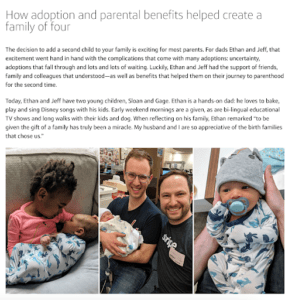5 Ways to Repurpose Video Content
You’ve just wrapped an employee story video. It’s authentic, it’s engaging, and it perfectly captures your culture. Now what? If you’re only hitting ‘publish’ on YouTube and calling it a day, you’re leaving serious storytelling potential—and ROI—on the table by not trying to repurpose the video content.
While video may be king in content marketing, repurposing that story across digital formats dramatically boosts engagement, reach, and longevity.
That one employee story can (and should) become a suite of strategic assets, each tailored for different platforms and moments in the candidate journey. In this post, we’ll share our favorite ways to extend the life of your video content and maximize its impact across channels.
Why Repurpose Video Content?
Let’s face it—your audience probably isn’t seeing your content the first time it goes live. And if you’re only sharing it on one or two channels, there’s a good chance some of your ideal candidates aren’t seeing it at all.
A strong employer brand strategy takes a multi-channel approach to meet talent where they are. One of the most efficient, budget-friendly ways to do that? Repurpose your video content into other assets.
By turning a single employee story video into four or five digital pieces, you’re filling your content calendar, increasing visibility, and getting more value out of every production. It’s not just smart—it’s scalable.
Plus, consistent content like this reinforces your brand story across touchpoints, without the heavy lift of creating something new every week.
5 Digital Formats that Elevate Your Video Stories
One employee story video has the potential to fuel an entire content library. With just one filmed interview, you can create assets tailored for different formats, channels, and moments in the candidate journey.
Here are five powerful ways to extend the life of your video content and maximize its reach and impact.
Social Graphics
From LinkedIn to Instagram, high-quality social graphics are always in demand. Your employee story video is the perfect source. Pull a compelling quote and a strong visual from the footage to create snackable, shareable content.
And make sure to optimize for each platform: use square formats for Instagram and landscape for LinkedIn. These graphics are ideal for spotlighting culture themes, celebrating employees, or drawing attention to hard-to-fill roles.
Blog Posts
A simple but powerful way to extend the value of an employee story video is by turning it into a blog post. Longer-form written content is especially valuable for candidates deeper in the hiring journey who want more context about specific roles, teams, or company culture.
Blog posts also offer SEO advantages. A well-built library of employee stories helps search engines (and AI tools) surface your brand in response to candidate queries, supporting both discoverability and conversion.
Most importantly, blog posts give you space to tell the whole story. You can expand on themes, experiences, and values that go beyond what a 60-second video can capture.
Testimonial Quotes
Each year, we analyze the career sites of the Fortune 100 Best Companies to Work For list, and this year, we saw a noticeable shift: a significant rise in the use of employee testimonials. One in four companies added new testimonial quotes or stories compared to the previous year.
It’s no surprise. Testimonial content is both easy to produce and highly effective. By pulling direct quotes from employee interviews, you can add authentic voices to your career site, job descriptions, and landing pages. When aligned with your EVP, these quotes reinforce your messaging and boost credibility.
Even better? They’re scalable. A single employee interview can yield multiple testimonials, ready to rotate seasonally or tailor to specific hiring campaigns.
Podcasts or Audio Clips
Not all content needs to be visual. Employee video interviews can also be repurposed into audio content. Think podcast episodes, behind-the-scenes clips, or even short-form audio ads. When you’re already recording high-quality video, you’re capturing high-quality audio by default.
Audio storytelling is especially effective for reaching deskless employees or on-the-go talent who may not be in front of a screen but still want to connect with your culture. It’s a smart way to extend your reach and deepen engagement—no screen time required.
Here’s an example of using employee stories on a podcast from PepsiCo.
Photography
Even if your filming day didn’t include a dedicated photographer, you can still capture high-quality visuals. Well-edited stills or screen grabs from your video content (like the example below) can be repurposed to support blog posts, social media, campaign visuals, and more.
When it comes to employer brand and recruitment marketing, stock photography should be a last resort. Real employee imagery builds trust, reflects your true culture, and resonates more deeply with candidates.
While professional photography is ideal for marquee assets, strategic use of video stills allows you to expand your visual library and maintain authenticity across channels, without the added production cost.
How to Repurpose Video Content
Repurposing starts with intentional planning. Here’s how to set yourself up for success:
- Plan ahead during pre-production. Before filming, identify the additional formats you’ll need—like social graphics, blog content, or photo stills. This can influence how you film. For example, if you know you’ll need usable stills, have employees pause and smile to make frame-grabbing easier in post-production.
- Collaborate with the right partners. Building a full suite of assets from one interview takes time. Working with an agency or creative partner can streamline the process, ensure consistency across formats, and help you produce more content, faster.
- Streamline your approvals. If your content needs review from legal, brand, or marketing teams, sharing a plan for all the repurposed assets upfront can reduce back-and-forth and accelerate publishing timelines.
- Keep track of your content. Create a tracking tool to identify your full library of stories so you can easily revisit footage to create new content.
It’s Possible to Create a Year of Content in One Day
Storytelling doesn’t stop once the video is live. That’s just the beginning. Every employee story has the potential to become a variety of content assets that extend your brand message across channels and throughout the year.
With some upfront planning, a single filming day can generate enough high-quality content to power your employer brand for months. By strategically repurposing video interviews into other formats, you’re not just creating content—you’re building a scalable content library that serves multiple teams and initiatives.
Need help mapping it out? We’d love to help you create a repurposing plan that maximizes your stories and your budget.





